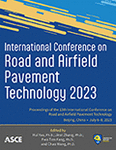Determination of Dynamic Coefficient of Friction of Pedestrian Pavement Using British Pendulum Test
Publication: International Conference on Road and Airfield Pavement Technology 2023
ABSTRACT
Human slipping on pedestrian pavements and other forms of paved areas is a problem worthy of great attention. Many countries have put forward test methods for assessing pedestrian slip resistance performance of pavements and floors. The British pendulum test (BPT) is one of the most common form of devices used for the purpose around the world to determine the slip resistance, and British pendulum number (BPN) is one of the most important parameters for pedestrian pavement safety evaluation. Although widely used as a form of measure of the slip resistance of a test surface, BPN is numerically not equal to 100 times the dynamic coefficient of friction (COF) of the test surface. It is difficult to directly compare and convert BPN and COF. The relationship between BPN and COF is nonlinear and would vary according to the slider force–deflection characteristics of the BPT device concerned. In practice, different units of BPT device would most likely have different slider force–deflection characteristics, and there will be a large deviation between the measurement results of different BPT devices. In this study, a numerical simulation model of BPT based on mechanical theory is proposed, which can convert the measured BPN values into the COF of the test surface to mechanically characterize the slip resistance of the flooring material. By so doing, the problem that the BPN measurements of different BPT devices vary with the force–deflection characteristics of the slider of the BPT device can be effectively solved.
Get full access to this article
View all available purchase options and get full access to this chapter.
REFERENCES
Lipscomb, H. J., Glazner, J. E., Bondy, J., Guarini, K., & Lezotte, D. (2006). Injuries from slips and trips in construction. Applied ergonomics, 37(3), 267-274.
Yeoh, H. T., Lockhart, T. E., & Wu, X. (2013). Non-fatal occupational falls on the same level. Ergonomics, 56(2), 153-165.
Derler, S., Huber, R., Kausch, F., & Meyer, V. R. (2015). Effectiveness, durability and wear of anti-slip treatments for resilient floor coverings. Safety Science, 76, 12-20.
Grönqvist, R., Hirvonen, M., & Tohv, A. (2000). Evaluation of three portable floor slipperiness testers. International Journal of Industrial Ergonomics, 25(1), 85-95.
Leclercq, S. (1999). The prevention of slipping accidents: A review and discussion of work related to the methodology of measuring slip resistance. Safety science, 31(2), 95-125.
Burnfield, J. M., & Powers, C. M. (2006). Prediction of slips: An evaluation of utilized coefficient of friction and available slip resistance. Ergonomics, 49(10), 982-995.
Sariisik, A. (2009). Safety analysis of slipping barefoot on marble covered wet areas. Safety Science, 47(10), 1417-1428.
Sariisik, A., Sariisik, G., & Akdaş, H. (2012). Slip analysis of surface-processed limestones. Proceedings of the Institution of Civil Engineers-Construction Materials, 165(5), 279-296.
ASTM (2013). ASTM E303-93. Standard test method for measuring surface frictional properties using the British pendulum tester. ASTM International West Conshohocken, PA.
BSI (2011). BS EN 13036-4 Road and airfield surface characteristics. Test methods for measurement of slip/skid resistance of a surface. The Pendulum Test. British Standards. London, UK.
Kim, I. J., & Kim, I. J. (2017). Pedestrian fall incidence and slip resistance measurements. Pedestrian fall safety assessments: Improved understanding on slip resistance measurements and investigations, 17-65.
Strautins, C., & Daniel, M. (2013). Integration of slip resistance values within a risk management framework: A human gait based approach using reference samples. In Proc of the international conference on fall prevention and protection, National Institute of Occupational Safety and Health, Tokyo, Japan (pp. 93-98).
Hiti, M., & Ducman, V. (2014). Analysis of the slider force calibration procedure for the British Pendulum Skid Resistance Tester. Measurement Science and Technology, 25(2), 025013.
NFSI (2009). B101.1 Test Method for Measuring Wet SCOF of Common Hard-Surface Floor Materials (ANSI/NFSI B101.1-2009). Southlake, TX: NFSI.
NFSI (2012). B101.3 Test Method for Measuring Wet DCOF of Common Hard-Surface Floor Materials (ANSI/NFSI B101.3-2012). Southlake, TX: NFSI
Tile Council of North America. (2012). American National Standard Specifications for Ceramic Tile (ANSI A137.1-2012). Anderson, SC: TCNA.
Health and Safety Executive UK. (2012). Assessing the slip resistance of flooring, A technical information sheet. British Standard, 7976.
AS/NZS 4586 (2013). Slip resistance classification of new pedestrian surface materials. Australian Standards.
BSI (2008). BS 8204-6. Screeds, bases and in situ floorings - Part 6: Synthetic resin floorings. Code of practice, European Committee for Standardization, Brussels.
Hiti, M., & Ducman, V. (2014). Analysis of the slider force calibration procedure for the British Pendulum Skid Resistance Tester. Measurement Science and Technology, 25(2), 025013.
ABAQUS. (2018). ABAQUS/explicit user’s manual, 2018. Version 2018. Hibbitt, Karlsson & Sorensen, Pawtucket, RI.
Liu, Y., Fwa, T. F., & Choo, Y. S. (2003). Finite-element modeling of skid resistance test. Journal of transportation engineering, 129(3), 316-321.
Information & Authors
Information
Published In
History
Published online: Feb 6, 2024
ASCE Technical Topics:
- Analysis (by type)
- Continuum mechanics
- Design (by type)
- Dynamics (solid mechanics)
- Engineering fundamentals
- Engineering mechanics
- Floors
- Friction
- Gravels
- Infrastructure
- Load and resistance factor design
- Load factors
- Models (by type)
- Numerical analysis
- Numerical models
- Pavement condition
- Pavements
- Pedestrians and cyclists
- Solid mechanics
- Structural design
- Structural engineering
- Structural systems
- Traffic engineering
- Transportation engineering
Authors
Metrics & Citations
Metrics
Citations
Download citation
If you have the appropriate software installed, you can download article citation data to the citation manager of your choice. Simply select your manager software from the list below and click Download.
